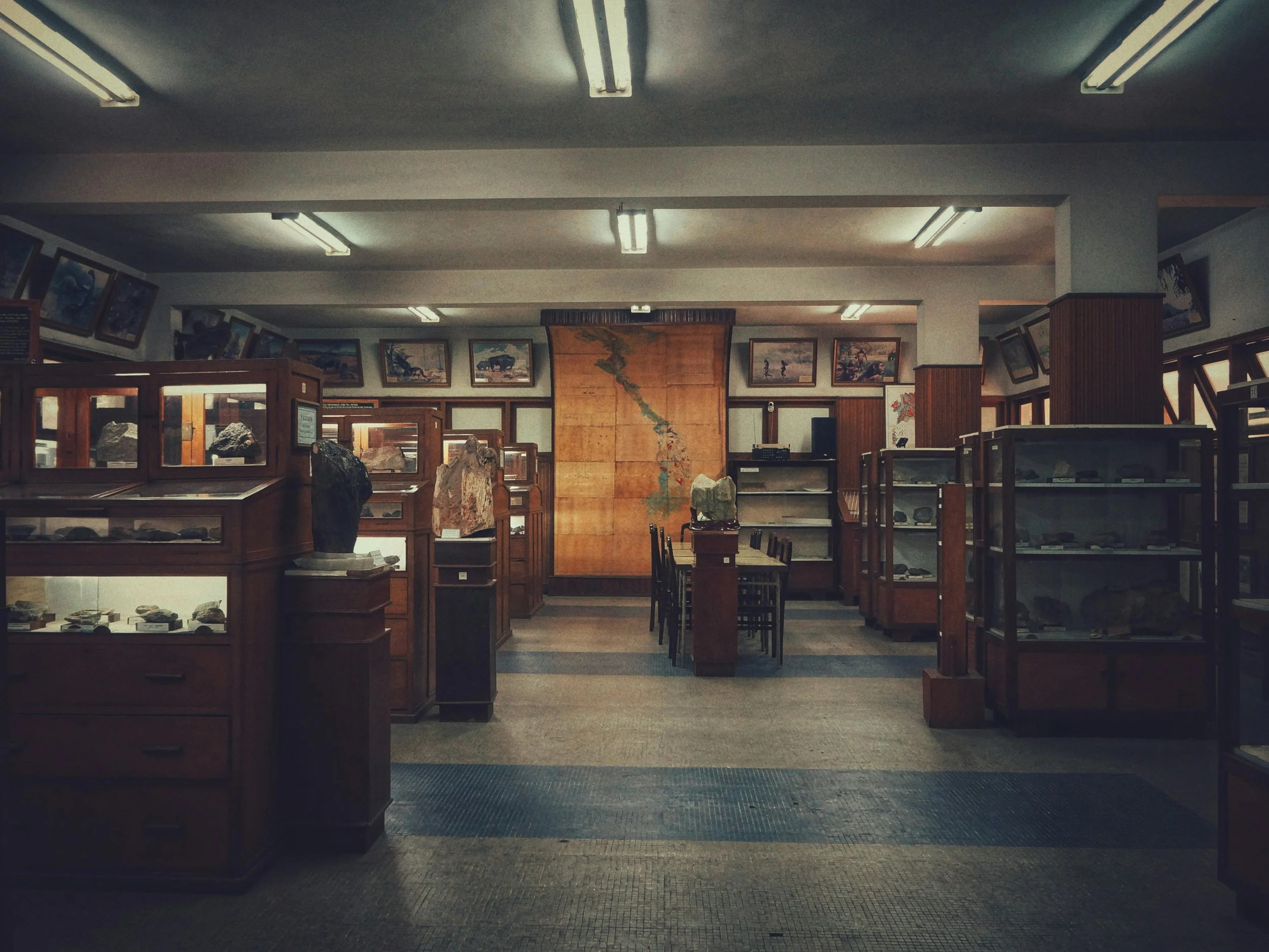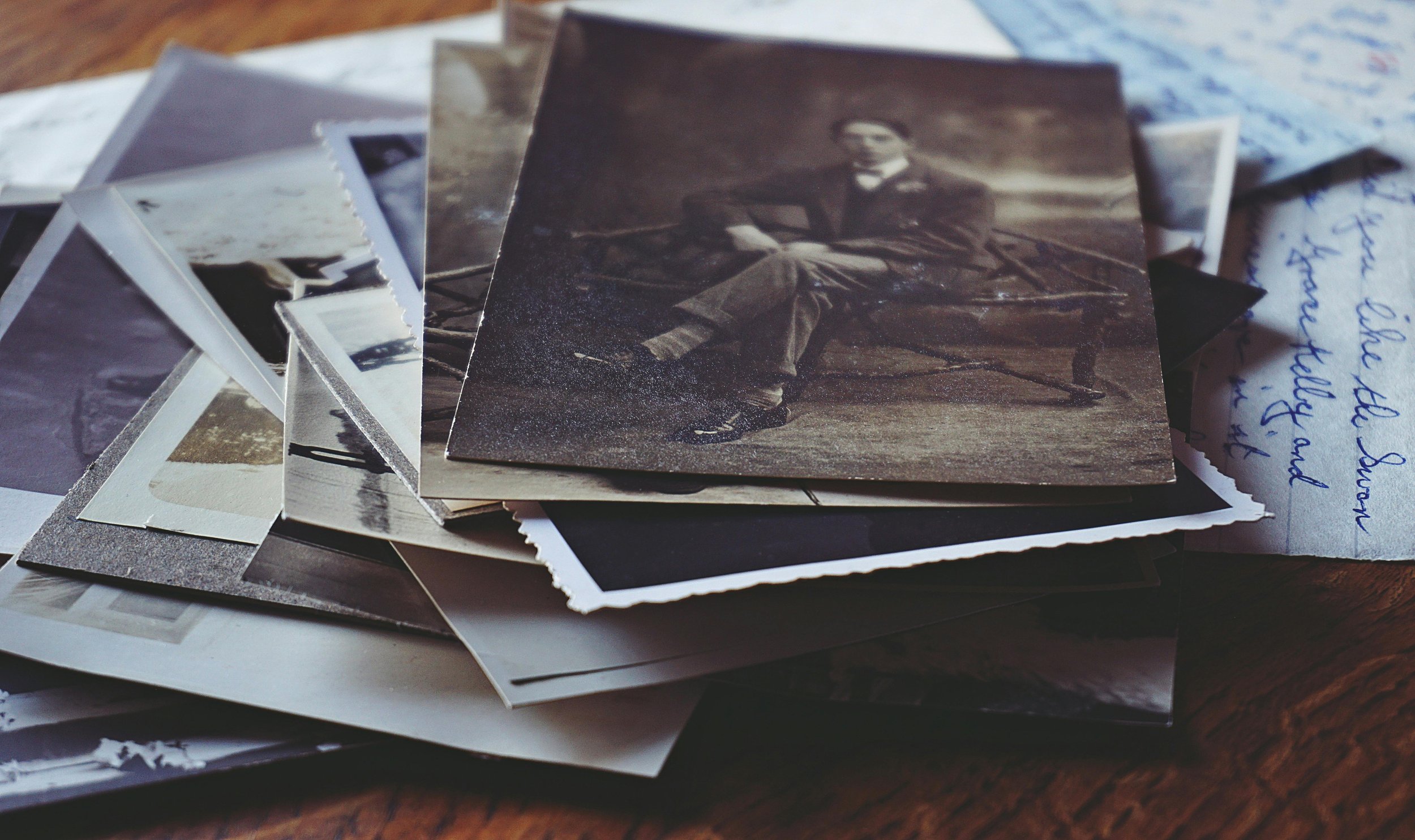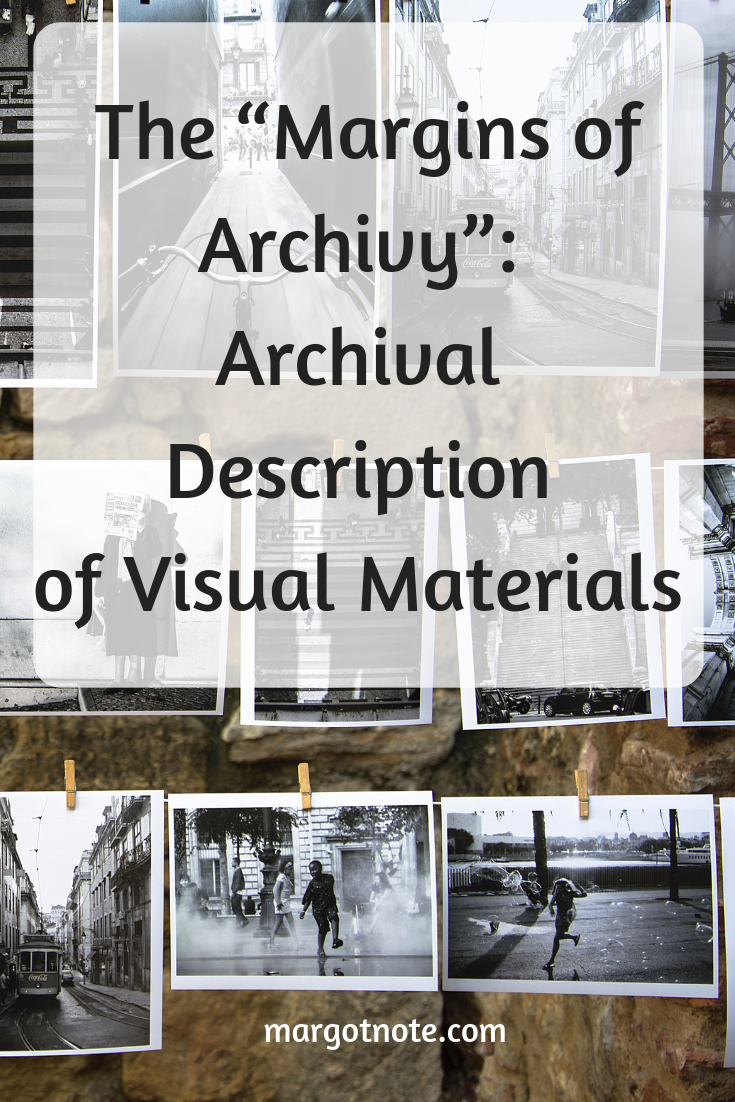While libraries have developed structured rules for cataloging print materials, these rules have not fully addressed the needs of image collections. Museums, on the other hand, have acquired great expertise in describing their unique holdings, but these practices vary because of the diverse nature of individual museums and their collections. Even with the emergence of online catalogs, web accessible collections, and improved information searching and navigation, access to visual collections has remained limited due to a lack of standardized description and integrated modes of access.
Increases in visual literacy, the use of photographs as primary sources, and technology’s ability to provide access to images over the Internet have created an impetus for many archival institutions to provide deeper descriptive information for their visual holdings (Kaplan & Mifflin, 2000). The Society of American Archivists (SAA) defines description as:
the process of creating a finding aid or other access tools that allow individuals to browse a surrogate of the collection to facilitate access and that improve security by creating a record of the collection and by minimizing the amount of handling of the original materials (Pearce-Moses, 2005).
Archivists describe their collections based on the principles of provenance and original order. However, unlike textual records, visual materials are often removed from their original locations and filed in subject files without further description. The context and purpose of an image is often not conveyed to those who were not present at the time of the event being captured. Thus, without an accurate record of the names, dates, and events depicted, an image holds little historical value. Schmidle (1996) notes, “Stripped of its original context, an old photograph is reduced to mere curiosity” (p. 14).
This paper discusses archival description of visual materials. SAA defines “visual materials” as “a generic term used to collectively describe items of a pictorial nature, including prints, paintings, photographs, motion pictures, and video (Pearce-Moses, 2005).[1] Current practices, challenges, and examples of image description will be explored. The archival profession has described visual materials inconsistently, making access difficult and regulating visual collections to the “margins of archivy” (Schwartz, 2002, p. 142).
Current Practices of Image Description
Libraries organize published, non-unique items (such as books and serials) using standards such as MARC and AACR2 with LCSH descriptors. Archives, museums, and visual resource collections create lengthy, detailed descriptions of unique materials or their representations (such as slides and digital images), which can be expressed as both collection- and item-level records.
Description expands upon information gleamed during appraisal and arrangement, which produces preliminary descriptive forms, such as container lists; summarizes the context and content of archival materials at multiple levels; and adds usage restrictions and access points for creators and subjects (Zinkham, 2006). Description often includes provenance, style or genre, history and use of the item, preservation details, various views of the item, and controlled vocabularies.
Description presents information not otherwise provided on the images; often there are no identifying texts. Without description, archivists must rely on staff memory or browse through images, which is time consuming and weakens images from handling. Undescribed images are vulnerable to theft and misfiling (Zinkham, 2006).
Schellenberg (1965) devotes the final chapter of Management of Archives to the arrangement and description of visual materials. He notes, “The methods of arranging and describing pictorial records have not been fully defined, much less standardized” (p. 322). Since the publication of his seminal book, formal standards, such as Describing Archives: A Content Standard (DACS), Graphic Materials, and Rules for Archival Description (RAD), have been developed for archival description of visual materials.[2] For example, the ISAD (G): General International Standard of Archival Description defines multilevel principles, such as moving from the broad to specific, linking hierarchical levels, and basic descriptive elements. These elements include creator names, titles, dates, administrative history, scope and content, and locations of originals and copies (International Council on Archives, 2000). While descriptive standards offer consistency, repositories employ descriptive systems suited to their holdings, not universal access, and archival description continues to be idiosyncratic (Pugh, 2005).
In their literature review, Greene and Meissner (2005) found that “[f]rom the mid-1960s to the present, archival authors have dismissed arrangement at the item level as having little utility and being thoroughly impractical for modern collections” (p. 213). Despite the literature, their repository and grant proposal surveys found that a large proportion of archivists have adhered to item-level description, even though it is contrary to the traditional archival practice of collection-level description. The same discrepancy between literature and practice appears to be true for visual collections.
Collection-level description can be useful for images of the same subject, but problematic for collections with a variety of subjects, as it neither improves retrieval nor limits handling of the originals. Ritzenthaler and Vogt-O’Connor (2006) agree that group arrangement and description are necessary and acceptable for large photograph collections or when resources are limited. Norris (1985), in his case study of two very large photograph processing projects, states that “something is better than nothing” for description at the group or collection level (p. 133).
However, item-level description is more common with visual materials than with textual materials. This is especially true for digital images, which by their nature, mandate it. Archivists must evaluate their visual collections to determine if item-level description is warranted. Critics like Dooley (1995) call item-level description of visual materials “insupportably expensive and unnecessary” and a “relic of a more leisurely past” (p. 88). Although it is time consuming, item-level description makes images searchable, and, with digital images, viewable without having to retrieve the originals. However, resources are seldom adequate to catalog all collections to the item level, and item-level handling should exist within a framework provided by group-level description. Repositories with limited budgets may digitize one or two representative images, while noting that there are additional unscanned images (Ritzenthaler & Vogt-O’Connor, 2006).
Access to image collections is usually provided through finding aids, which only include subject indexing for large collections, if at all. Studies indicate that, among a variety of libraries and archives, the most frequent approach to image retrieval is by subject (Armitage & Enser, 1997). However, archival practices vary considerably, depending on the repository, the resources available, the size and requirements of the collection, and user needs.
With the advent of computers, some institutions used MARC records to provide subject indexing for large pictorial archives through individual collection-level records (Ritzenthaler & Vogt-O’Connor, 2006). The MARC records point users to a finding aid for a particular collection for more detailed information. Since the finding aids were generally paper-based, and often only available locally at the institution, users would have to view them in person.
Item-level MARC cataloging of images, while in some cases desirable, was often neither warranted nor economically feasible (Ritzenthaler & Vogt-O’Connor, 2006). The hierarchical format and electronic access capabilities of the Encoded Archival Description (EAD) finding aid, however, offers the possibility of a more powerful, flexible alternative. EADs index image collections by providing access points at the collection or item level, depending on the needs of the institution, collection, and users. As the tools for accessing finding aids become more sophisticated, EADs’ content-specific indexing capabilities will make it a powerful resource for standardized, integrated access to primary source visual collections.
Challenges of Image Description
Like all other archival materials, images are organized and made accessible based on their original order and provenance, but because of their uniqueness, value, subject matter, and historical significance, they present challenges for description. Unlike archives and manuscripts, visual collections often do not have a clearly defined or pre-existing organizational structure, individual titles, or creator names by which they can be described (Ritzenthaler & Vogt-O’Connor, 2006). Baxter (2003) notes that the use of visual collections shaped their description. For instance, early photography collections held at the New York Public Library were treated at bibliographic materials before their recognition as archival resources (Weinstein & Booth, 1977, and Ritzenthaler, Munhoff, & Long, 1984, as cited in Baxter, 2003).
Additionally, when images are indexed, they may not only be described in terms of being “about” a subject but also “of” a subject and, as a result, descriptive access points can be numerous. This knowledge hierarchy is similar to Panofsky’s (1939) preiconographic, iconographic, and iconology levels and traditional subject-headings like broad term, near term, and related term.[3]
Finnegan (2006) argues that image description is inherently subjective, requiring complex conceptual and ideological processes to determine the subject. “Image archives … function as terministic screens, simultaneously revealing and concealing ‘facts,’ at once enabling and constraining interpretation” (p. 118). Interpretation is needed because, as Huyda (1977) writes, “existing captions are often incomplete, inaccurate, deliberately distorted or irrelevant” and that “the attribution of photographs to particular photographers or studios is a complicated process” (p. 10). Additionally, visual materials have lacked description and lagged behind their textual counterparts in automated access because they have held a lower priority in archives (Turner, 1993).
Description is subjective because information is assigned to images, as they are usually not accompanied by textual information. Image retrieval, therefore, translates the users’ cognitive visual needs to descriptive systems entries. Archivists must be able to assist users articulate their information needs, as well as be able to match that expression to an existing image. Image description surrogates, such as keywords, titles, captions, or cataloging records, act as attributes against which a query may be matched and provide support for browsing, navigation, relevance judgment, and query reformulation (Goodrum, 2005).
The lack of visual literacy by both archivists and researchers presents difficulties for archival description of image collections. Since the mid-to-late twentieth century and the rise of the history of social movements and under-represented segments of society, historians had neglected non-textual sources in their research (Kaplan & Mifflin, 2000). Burke (2001) writes of the training of historians:
The criticism of visual evidence remains undeveloped, although the testimony of images, like that of text, raises problems of context, function, rhetoric, recollection whether soon or long after the event, secondhand witnessing and so on (p. 15 as cited in O’Toole & Cox, 2006, p. 200 n. 54).
Similarly to historians, archivists have been under-schooled in visual literacy. Library science and archival programs devote little attention to visual materials in the curriculum, although professional development classes in photographs are offered by SAA (Kaplan & Mifflin, 2000).
Schwartz (2002) argues that current descriptive practices relegate images to the “margins of archivy” through the archival profession’s
ideas and standards, practices and actions, whether consciously or unconsciously, intentionally or unintentionally, overtly or systemically … By embracing a textual model of recorded information and by adopting a bibliographic model of image classification, [archivists] continue to fixate on the factual content rather than the functional origins of visual images (p. 142-3).
Schwartz notes that it is difficult to apply traditional hierarchical description to visual materials and to understand that hierarchical levels of description are intellectual constructs that may not have material equivalents. She writes:
Traditional item-level description of photographs, indexed by subject and credited to the photographer, but without adequate contextual information about their functional origins and provenance, or clear links to such contextual information, transforms photographic archives into stock photo libraries, reducing photographs to their visible elements, and conflating photographic content and photographic meaning (p. 157).
Schwartz’s criticisms demonstrate deficiencies in archival theory and practice, which remain unable to address the unique challenges of archival description of image collections.
Image Description Examples
Teber (2004) discusses a survey that the Audio-Visual Archives (A-V Archives) at the University of Kentucky conducted of 24 institutions with newspaper photo morgues. Each institution reported different degrees of arrangement and description, with 18% reporting that the collections were unprocessed. Of the processed collections, both the interpretation of “full processing” and the resources expended differed by institution. Full processing can range from EADs, item-level description, and rehousing to brief, folder-level description. Although survey responders did not define their interpretation of fully processed, 25% have fully processed collections (with 11% of that total with EADs), 14% had collections that were over half-processed, and 43% had less than one half of the collection processed (p. 114).
Respondents noted that because the collections have high local interest and repetitive images (especially with the advent of roll film), description was often minimal. Ideally, each series of photographs should have the location, date, and subject, searchable by a finding aid or a database. This is especially important if the collection is maintained in the original order produced by the newspaper, which may not easily serve users’ purposes. Although newspaper photo morgues represent a specific type of image collection, with its own distinct attributes and challenges, the results of the survey provided real-world insight into the description of visual collections.
Alexander and Meehleib (2001) note that the Library of Congress, Prints and Photographs Division (P&P) catalogers employ practices from libraries, museums, and archives. They evaluate the appropriate description treatment for a given group of materials: whether the images should be cataloged at the item, group, or collection level. P&P catalogers create catalog records and finding aids, frequently using a combination of description levels to facilitate access. This blended approach allows broad control over the holdings at the group level as well as specific control over individual images at the item level. This is especially important for high-demand images, images used in exhibits, or images with high intrinsic or market value. Although P&P represents a large image collection with vast resources, this example demonstrates that evaluative methods determine the level of description required.
Archival Description for Visual Materials
Archival description of images has sought to combine traditional library and archival practice with the more focused descriptive practices found in the museum and visual resources communities. Description of images remains challenging. Due to the nature of visual material, a standardized approach for description is ideal, but compromises must be made. All images cannot be indexed completely, nor can all resources be expended on indexing only a few collections. Approaches should be equitable, reasonable, and within the means of the institution. While there are challenges to be found when working with visual materials, these objects hold a wealth of information that justifies the additional effort needed to make them accessible. Archivists must draw visual materials from the “margins of archivy” and establish them in their rightful place as records of enduring value and primary sources of informational and evidential importance for future generations.
Works Cited
Alexander, A., & Meehleib, T. (2001). The thesaurus for graphic materials: Its history, use, and future. Cataloging & Classification Quarterly 31, 189-212.
Armitage, L. H., & Enser, P. G. B. (1997). Analysis of user need in image archives. Journal of Information Science 23(4), 287-299.
Baxter, G. (2003). The historical photograph: Record, information source, object, resource. Art Libraries Journal 28(2), 4-12.
Burke, P. (2001). Eyewitnessing: The uses of images as historical evidence. Picturing history series. Ithaca: Cornell University Press.
Dooley, J. M. (1995). Processing and cataloging of archival photograph collections. Visual Resources 11(1), 85-101.
Finnegan, C. A. (2006). What is this a picture of?: Some thoughts on images and archives. Rhetoric & Public Affairs 9(1), 116-123.
Goodrum, A. A. (2005). I can’t tell you what I want, but I’ll know it when I see it: Terminological disconnects in digital image reference. Reference & User Services Quarterly 45(1), 46-53.
Green, M. A., & Meissner, D. (2005). More product, less process: Revamping traditional archives processing. American Archivist 68(2), 208-263.
Huyda, R. (1977). Photographs and archives in Canada. Archivaria (5), 5-16.
International Council on Archives. (2000). ISAD(G): General international standard archival description. Ottawa: ICA. Retrieved May 7, 2018, from the International Council on Archives Web site: http://www.ica.org/sites/default/files/isad_g_2e.pdf
Kaplan, E., & Mifflin, J. (2000). “Mind and sight”: Visual literacy and the archivist. In R. C. Jimerson (Ed.) American archival studies: Readings in theory and practice. Chicago: Society of American Archivists.
Norris, T. D. (1985). Processing extremely large collections of historical photographs. The Midwestern Archivist 10(2), 129-134.
O’Toole, J. M., & Cox, R. J. (2006). Understanding archives & manuscripts. Archival fundamentals series. Chicago: Society of American Archivists.
Panofsky, E. (1939). Studies in iconology; Humanistic themes in the art of the renaissance. New York: Oxford University Press.
Pearce-Moses, R. (2005). A glossary of archival and records terminology. Chicago: Society of American Archivists. Retrieved May 5, 2009, from the Society of American Archivists Web site: http://www.archivists.org/glossary/index.asp
Pugh, M. J. (2005). Providing reference services for archives & manuscripts. Archival fundamentals series. Chicago: Society of American Archivists.
Ritzenthaler, M., Munhoff, G., & Long, M. (1984). Archives and manuscripts: administration of photographic collections. Chicago: Society of American Archivists.
Ritzenthaler, M., & Vogt-O’Connor, D. (2006). Photographs: Archival care and management. Chicago: Society of American Archivists.
Schellenberg, T. R. (1965). The management of archives. New York: Columbia University Press.
Schmidle, R. (1996). The smile and promise of digital imaging: Preserving photographs in a digital world. Library Hi Tech News, (130), 14-16.
Schwartz, J. M. (2002). Coming to terms with photographs: Descriptive standards, linguistic ‘othering,’ and the margins of archivy. Archivaria 54, 142-171.
Teper, J. H. (2004). Newspaper photo morgues—a survey of institutional holdings and practices. Library Collections, Acquisitions, and Technical Services 28(1), 106-125.
Turner, J. M. (1993). Subject access to pictures: Considerations in the surrogation and indexing of visual documents for storage and retrieval. Visual Resources 9(3), 245-247.
Weinstein, R. A., & Booth, L. (1977). Collection, use and care of historical photographs. Nashville: American Association for State and Local History.
Zinkham, H. (2006). Description and cataloging. In M. L. Ritzenthaler & D. Vogt-O’Connor (Eds.) Photographs: Archival care and management. (pp. 164-206). Chicago: Society of American Archivists.
[1] Visual materials are synonymous with “nontextual records,” which “include records formats that are not principally words on paper, such as maps, photographs, motion pictures and video, sound recordings, and the like” and “nonprint materials” which are “items that are not books, periodicals, or pamphlets; nonbook materials” (Pearce-Moses, 2005). The majority of archival literature on nontextual records discusses photographs, but my arguments can be extended to all visual materials as defined by SAA.
[2] For practical instruction on the description of visual materials, see: Zinkham, H. (2006). Description and cataloging. In M. L. Ritzenthaler & D. Vogt-O’Connor (Eds.) Photographs: Archival care and management. (pp. 164-206). Chicago: Society of American Archivists.
[3] For more information on cognitive image levels, see: Note, M. (2008). [Review of Howard F. Greisdorf and Brian C. O'Connor, Structures of Image Collections: From Chauvet-Pont-d'Arc to Flickr]. The American Archivist. 71(2), 571.
GET STARTED
Looking for archival advising, records management, and historical research services? Click below to speak with an expert consultant.































